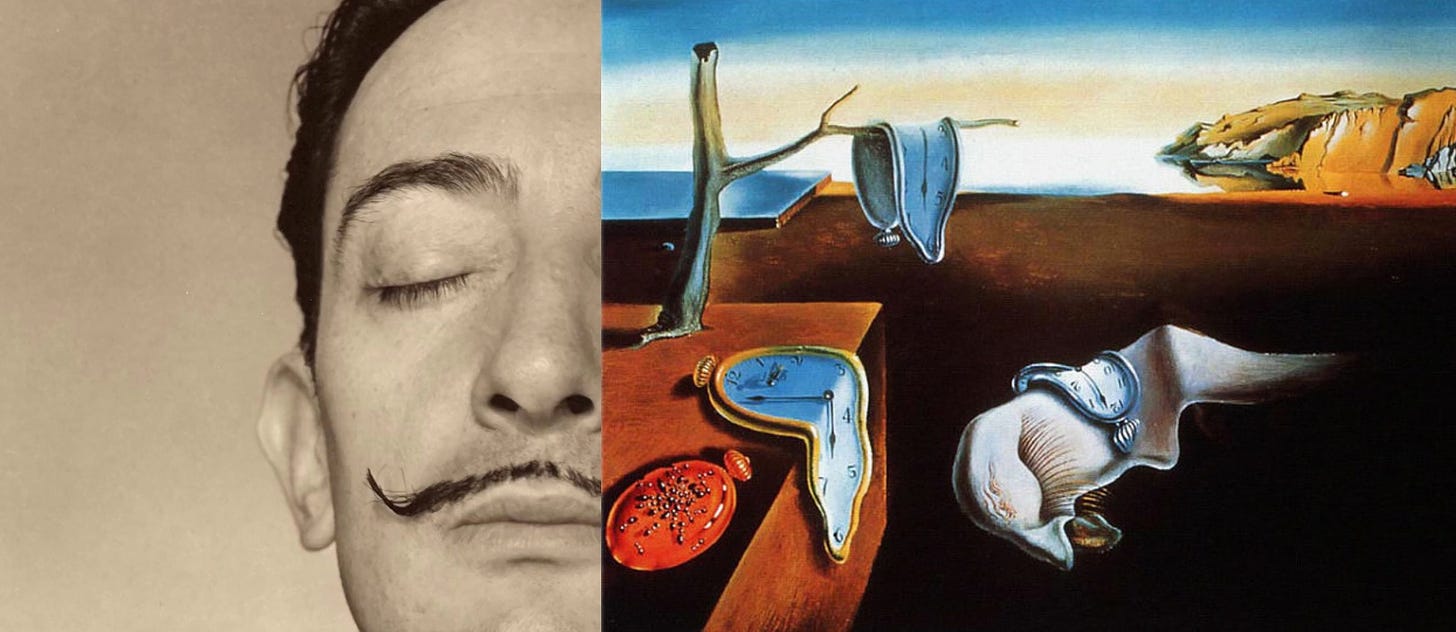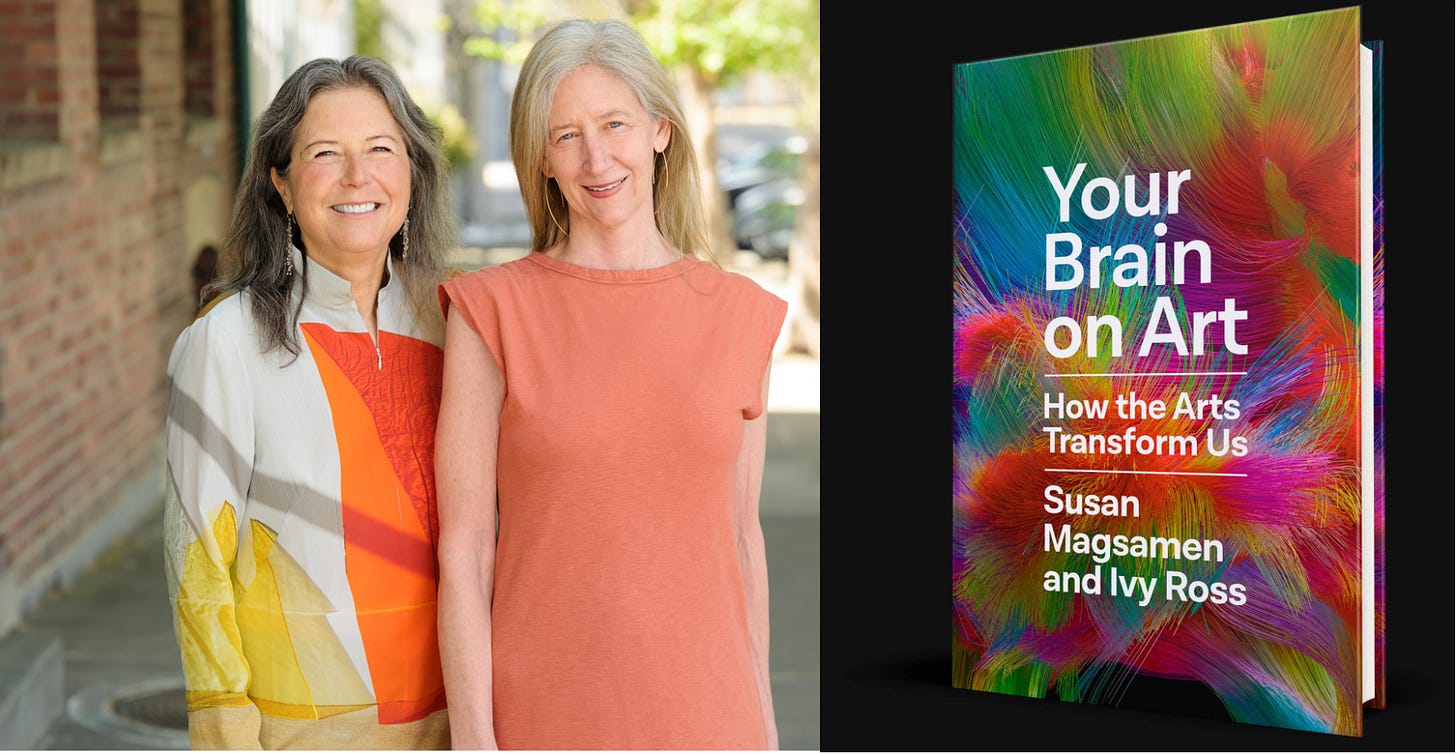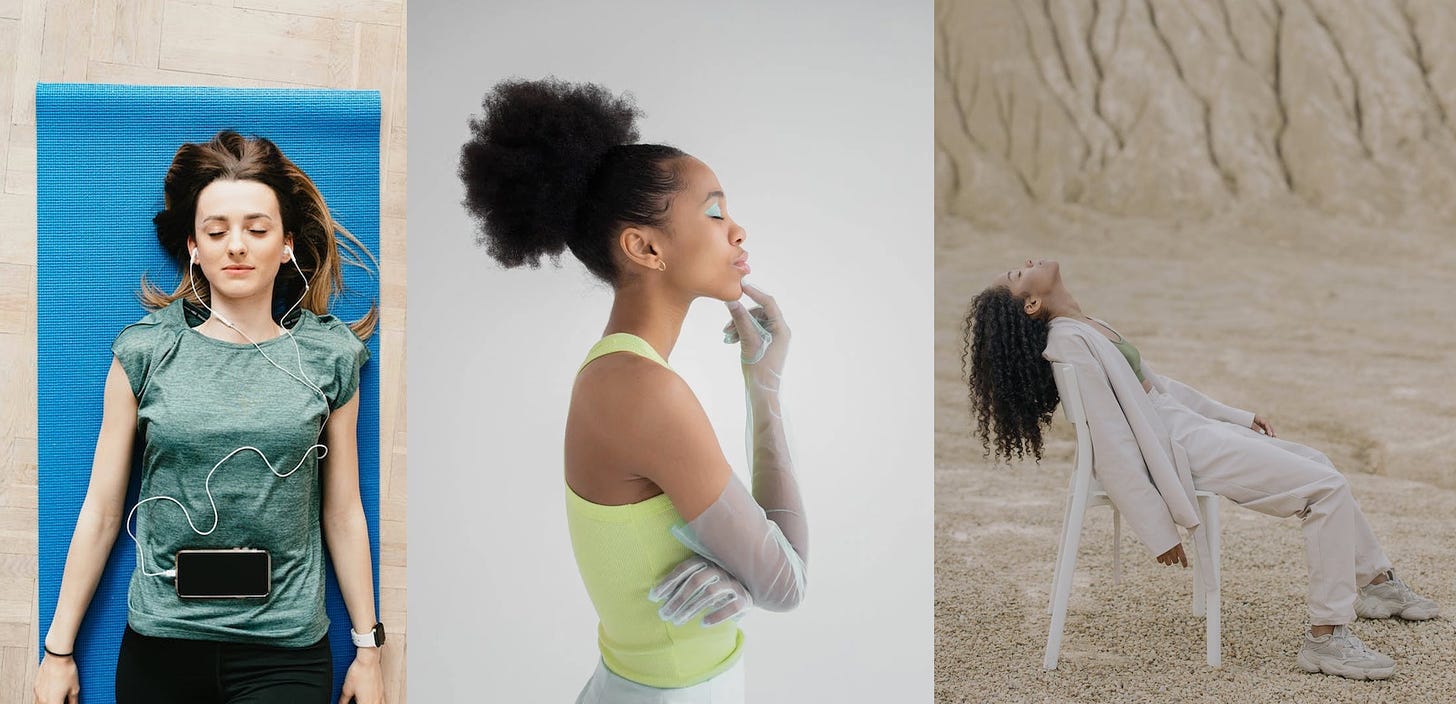🍄 Microdozing
Forget Microdosing—Try Microdreaming for Creativity. Into the dreaming mind, the global neurotech market is projected to hit USD 38.17 Billion by 2032.
Exploring every rabbit hole there is. For more wanderings, become an Alice in Futureland subscriber—it's free.
🍄 AudioDose: this is Alice on Sonic Mushrooms. Earth dreams here.
🎧 Creativity, Consciousness and Lucid Dreaming with Michelle Carr, dream engineer & Dr. Stephen LaBerge (from the archives)
Hello, we’re Alice and we are always in a state of wander. "Microdreams" are short dream snippets, usually less than 1 second long, that appear in your thought just as you are about to doze off.
The master surrealist Salvador Dali was a microdreamer, which he called his "slumber with a key." Dali shared his afternoon slumber technique to fellow painters as a way to access visual inspiration.
His instructions for the “slumber with a key” are as follows:
“You must seat yourself in a bony armchair, preferably of Spanish style, with your head tilted back and resting on the stretched leather back. Your two hands must hang beyond the arms of the chair, to which your own must be soldered in a supineness of complete relaxation. […]
In this posture, you must hold a heavy key which you will keep suspended, delicately pressed between the extremities of the thumb and forefinger of your left hand. Under the key you will previously have placed a plate upside down on the floor…. The moment the key drops from your fingers, you may be sure that the noise of its fall on the upside down plate will awaken you.”
Source: Psychology Today
🎧 👁🗨 You can practice this today using a chair, spoon & a plate. Dream engineer and researcher Michelle Carr explains how to get yourself into the sleep onset state for an anytime creativity boost on her podcast with with ALICE. Or watch here.
Life What Is It, But a Dream?
When you are about to fall asleep, your brain is actively taking in real-life experiences and images and turning them into ultra-quick dream experiences and images. Often times, these quick dreams jolt us awake—creating an active microdream state. Nielsen’s research, published in the journal Neuroscience of Consciousness, explored how people dreamed during the transition from wakefulness to sleep. This transition state is not the playground for complex or surreal dreams we may experience during REM sleep, but, as Nielsen discovered, it is almost like a photograph of a recent memory or physical stimulus that we combine with existing knowledge and turn it into a fleeting image. That is the creative juice of a microdream.
To recall a microdream—or even be aware of having one—you need to practice self-observation. One technique is the “upright napping” procedure. It is one technique that researcher Tore Nielsen uses in his studies of the memory sources of microdreams. Nielsen is a psychologist and director of the Dream & Nightmare Lab at the Université de Montréal.
Creativity and the wandering mind
In their groundbreaking book "Your Brain on Art,” the authors Susan Magsamen and Ivy Ross journey through the science & everyday applications of neuroaesthetics, with compelling proof for how our brains and bodies transform when we participate in the arts. The authors draw from their own interdisciplinary view of arts and sciences—Susan is the founder and director of the International Arts + Mind Lab, Center for Applied Neuroaesthetics at Johns Hopkins University School of Medicine and Ivy is a renowned designer, artist and currently Vice President of Design for the Hardware Product Area at Google. One of the many life-changing examples they cover that can impact our health, increase our longevity and help individuals and communities flourish is the simple act of mind wandering, or what some experts call positive constructive daydreaming.
“Taking a break from a task at hand, for instance, and allowing your mind to wander as you engage in the act of art-making can spark seemingly spontaneous solutions. You’ve allowed your brain to go offline for a moment and daydream. It’s believed that the seat of mind wandering may be your default mode network, and it is a fascinating and important neurological skill. Basically, your brain disrupts some of its own cognitive activity—such as actively processing your external environment—in order to protect your internal imaginings. Mind wandering in this way has been shown to increase our creativity.”
—Susan Magsamen and Ivy Ross, “Your Brain on Art: How the Arts Transform Us” (Random House, March 2023)
Hack Your Dreams
Did you know you can enhance your dream life by sleeping with a glove on? Nielsen claims that by wearing a single glove to bed can produce more easily recalled dreams that are more vivid than usual. He calls this the "Black Glove Effect"and it can also increase the likelihood of experiencing a lucid dream.
Dream X Engineering
Through touch, scent and sound, dream engineers help people rescript the dramas of their sleeping lives. Adam Horowitz and other team members at MIT Media Lab recently presented a dream protocol that uses repeated exposure to specific auditory stimuli is given during the sleep onset period, enabling targeted dream incubation, or TDI. Using Dormio, a wearable electronic glove device, they incubated the word "Tree" and were able to show direct incorporation of the target word into dream content. They were able to then prove that the verbal incubation of dream content delivered a creative benefit on tasks related to the incubated theme of ‘Tree,” including a Creative Storytelling Task. This is the first documented study demonstrating a causal role for dream content in the enhancement of creative performance.
Daydream Believer
Sleep engineers have been mining dreams for millennia – but even the most innovative research today combines cutting-edge tech with ancient techniques. Studies at Dr. Stephen LaBerge’s Lucidity Institute, for example, reference Tibetan Dream Yoga (also known as Milam) today. In Ancient Greece, philosopher Aristotle spoke of being conscious while dreaming, and Saint Augustine was the first to record a patient encounter that closely resembles what we now consider lucid dreaming. In 1867, French academic Marquis d’Herrey Saint-Denys published a book called ‘Dreams and how to Guide Them.’ And finally the term ‘lucid dreaming’ was coined in 1913, by Dutch physician Frederik Willem van Eeden founder of The Lucidity Institute, during an address to the Proceedings of the Society for Psychical Research.
When the English writer, Mary Arnold-Forster, detailed her lucid dreaming descriptions in her book, Studies in Dreams, in 1921, she proposed that humans have a dual consciousness. The idea still tugs today. “There’s a grouping of higher-level features, which seem to be very closely associated with what we think of as human consciousness, which come back in that shift from a non-lucid to a lucid dream,” Dr. Benjamin Baird told The Guardian. “And there’s something to be learned in looking at that contrast.”
🧠 Daydreaming has all sorts of benefits and is particularly important for developing brains.
🧠 Daydreaming also has a dark side. Are you excessively daydreaming? Psychologists call this maladaptive daydreaming—and it can undermine your ability to cope with everyday life.
🧠 A team of psychologists tracked the mental states of 15,000 volunteers and found that adults spend around half their waking hours daydreaming.
🧠 Nap those ideas: A study from Institute du Cerveau suggests that a short nap is a great way to solve creative problems.
🧠 Snooze away brain fog: Perhaps taking a regular afternoon nap may be the cure for the afternoon slump and the persistent brain fog. Researchers found sleeping in the afternoon was associated with better locational awareness, verbal fluency and working memory in an aging Chinese population.
Craving more?
📘 Alice in Futureland books
🎧 Alice in Futureland Podcasts
🎧 Benefits of Lucid Dreaming with Michelle Carr, dream engineer & Dr. Stephen LaBerge, psychophysiologist specializing in the scientific study of lucid dreaming (from the archives)
🎧 Creativity, Consciousness and Lucid Dreaming with Michelle Carr, dream engineer & Dr. Stephen LaBerge (from the archives)
🎧 Dream Yourself Well with Michelle Carr & Dr. Stephen LaBerge (from the archives)
👁🗨 Practice Your Sleep Onset State with Michelle Carr, dream engineer
Thanks for tuning in.
For more wanderings, become an Alice in Futureland subscriber—it's free.
Invite your friends to this mad tea party and let's see how many things we can learn before breakfast.
©2023 Alice in Futureland








